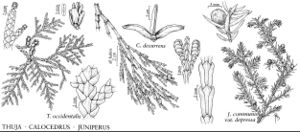Difference between revisions of "Calocedrus decurrens"
Taxon 5: 192. 1956.
FNA>Volume Importer |
imported>Volume Importer |
||
| (7 intermediate revisions by 2 users not shown) | |||
| Line 8: | Line 8: | ||
}} | }} | ||
|common_names=Incense-cedar;cedro incienso | |common_names=Incense-cedar;cedro incienso | ||
| − | |basionyms={{Treatment/ID/ | + | |special_status={{Treatment/ID/Special_status |
| + | |code=F | ||
| + | |label=Illustrated | ||
| + | }} | ||
| + | |basionyms={{Treatment/ID/Basionym | ||
|name=Libocedrus decurrens | |name=Libocedrus decurrens | ||
|authority=Torrey | |authority=Torrey | ||
| + | |rank=species | ||
| + | |publication_title=Smithsonian Contr. Knowl. | ||
| + | |publication_place=5(1) [6(2)]: 7, plate 3. 1853 | ||
}} | }} | ||
|synonyms= | |synonyms= | ||
| Line 20: | Line 27: | ||
}}<!-- | }}<!-- | ||
| − | --><span class="statement" id="st- | + | --><span class="statement" id="st-undefined" data-properties=""><b>Trees </b>to 57 m; trunk to 3.6 m diam. <b>Bark</b> cinnamon brown, fibrous, furrowed and ridged. <b>Branchlet</b> segments mostly 2 or more times longer than wide, broadening distally. <b>Leaves</b> 3–14 mm, including long-decurrent base, rounded abaxially, apex acute (often abruptly), usually mucronate. <b>Pollen</b> cones red-brown to light brown. <b>Seed</b> cones oblong-ovate when closed, red-brown to golden brown, proximal scales often reflexed at cone maturity, median scales then widely spreading to recurved, distal scales erect. <b>Seeds</b> 4 or fewer in cone, 14–25 mm (including wings), light brown. <b>2n</b> = 22.</span><!-- |
-->{{Treatment/Body | -->{{Treatment/Body | ||
| Line 35: | Line 42: | ||
-->{{#Taxon: | -->{{#Taxon: | ||
name=Calocedrus decurrens | name=Calocedrus decurrens | ||
| − | |||
|authority=(Torrey) Florin | |authority=(Torrey) Florin | ||
|rank=species | |rank=species | ||
| Line 48: | Line 54: | ||
|publication title=Taxon | |publication title=Taxon | ||
|publication year=1956 | |publication year=1956 | ||
| − | |special status= | + | |special status=Illustrated |
| − | |source xml=https:// | + | |source xml=https://bitbucket.org/aafc-mbb/fna-data-curation/src/2e0870ddd59836b60bcf96646a41e87ea5a5943a/coarse_grained_fna_xml/V2/V2_445.xml |
|genus=Calocedrus | |genus=Calocedrus | ||
|species=Calocedrus decurrens | |species=Calocedrus decurrens | ||
| − | |||
| − | |||
| − | |||
| − | |||
| − | |||
| − | |||
| − | |||
| − | |||
| − | |||
| − | |||
| − | |||
| − | |||
| − | |||
| − | |||
| − | |||
| − | |||
| − | |||
| − | |||
| − | |||
| − | |||
| − | |||
| − | |||
| − | |||
| − | |||
}}<!-- | }}<!-- | ||
-->[[Category:Treatment]][[Category:Calocedrus]] | -->[[Category:Treatment]][[Category:Calocedrus]] | ||
Latest revision as of 21:23, 5 November 2020
Trees to 57 m; trunk to 3.6 m diam. Bark cinnamon brown, fibrous, furrowed and ridged. Branchlet segments mostly 2 or more times longer than wide, broadening distally. Leaves 3–14 mm, including long-decurrent base, rounded abaxially, apex acute (often abruptly), usually mucronate. Pollen cones red-brown to light brown. Seed cones oblong-ovate when closed, red-brown to golden brown, proximal scales often reflexed at cone maturity, median scales then widely spreading to recurved, distal scales erect. Seeds 4 or fewer in cone, 14–25 mm (including wings), light brown. 2n = 22.
Habitat: Montane forests
Elevation: 300–2800 m
Distribution
Calif., Nev., Oreg., Mexico in Baja California.
Discussion
Incense-cedar is an important commercial softwood species. Its wood, exceptionally resistant to decay and highly durable when exposed to weather, is manufactured into many products, including lumber, pencil stock (for which it is the major United States source), fence posts, shakes, and landscape timbers, which are attractive because of punky spots resulting from fungus. The tree is widely grown as a handsome ornamental.
Selected References
None.
